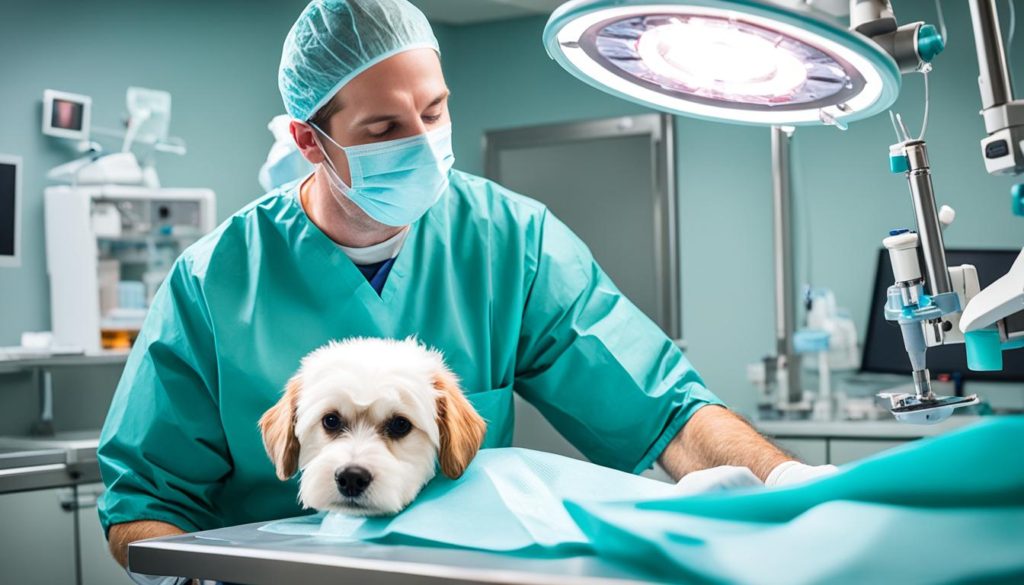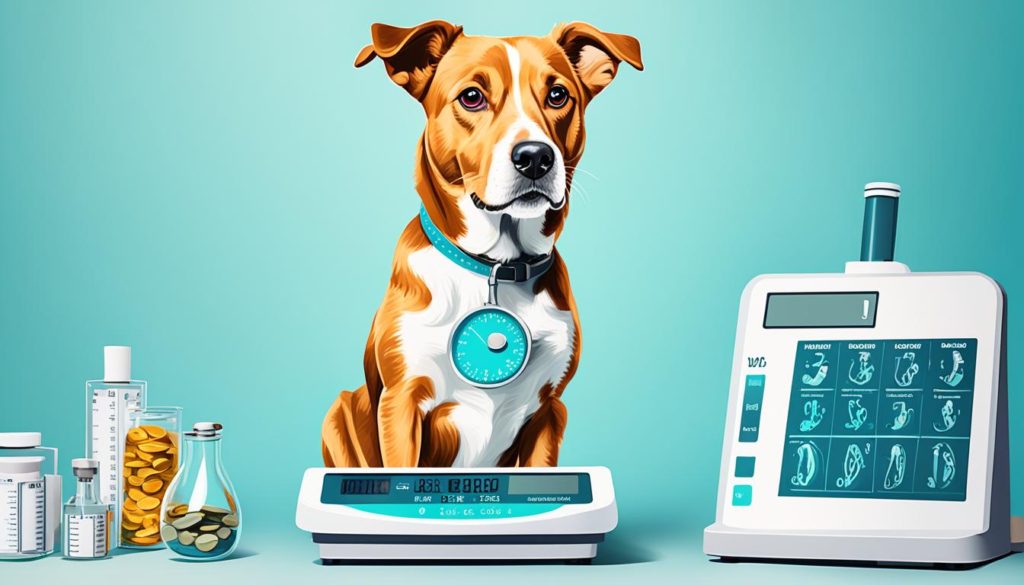When it comes to your beloved furry friend’s health, it’s essential to be prepared for any medical situation that may arise, including dog mammary tumors. These growths can be benign or malignant, and their removal can vary in cost depending on several factors. Understanding the potential expenses involved will help you make informed decisions about your dog’s well-being.
From the size and type of the tumor to the expertise of the veterinarian performing the surgery, there are multiple elements that can affect the cost of dog mammary tumor removal. By considering these factors, you can navigate the process confidently and plan your budget accordingly.
Throughout this guide, we will delve into the various aspects that influence the cost of dog mammary tumor removal. By the end, you’ll have a comprehensive understanding of the potential expenses involved and be better equipped to make decisions that align with your dog’s health needs.
Key Takeaways:
- Costs for dog mammary tumor removal can vary widely depending on factors such as tumor size, type, and location.
- The expertise of the veterinarian performing the surgery can influence the overall cost.
- Understanding the inclusions of the cost, such as anesthesia, operating room use, biopsy, and associated treatments, can help you assess the value.
- While surgery may be necessary for some tumors, the type and impact on your dog’s quality of life will determine the course of action.
- By being aware of potential costs and considering various factors, you can make informed decisions about your dog’s health while managing your budget effectively.
Factors Affecting Dog Mammary Tumor Removal Cost
The cost of dog mammary tumor removal can be influenced by various factors. It’s important to consider these factors when estimating the expenses associated with the procedure.
- Size of Tumor: The size of the tumor is one of the key determinants of the cost. Larger tumors often require more extensive surgical procedures and may need to be removed in an operating room, leading to higher costs.
- Type of Tumor: The type of tumor, whether benign or malignant, can impact the cost. Different types of tumors may require different surgical approaches and treatments, affecting the overall expenses.
- Location of Tumor: The location of the tumor also plays a role in the complexity of the surgery and the associated costs. Tumors located on the skin or near internal organs may require more intricate procedures, leading to higher expenses.
- Who Performs the Surgery: The cost may vary depending on whether a general veterinary practitioner or a board-certified veterinary surgeon performs the tumor removal. Specialists may have higher fees due to their advanced training and expertise.
Considering these factors can help pet owners understand why the cost of dog mammary tumor removal can vary. It’s essential to consult with a veterinarian to get an accurate estimate based on your dog’s specific situation.
Example Table: Average Cost Variation Based on Tumor Factors
| Tumor Size | Tumor Type | Tumor Location | Surgeon Expertise | Average Cost |
|---|---|---|---|---|
| Small | Benign | Subcutaneous | General Practitioner | $500 – $1,000 |
| Large | Malignant | Adjacent to Organ | Board-Certified Surgeon | $5,000 – $10,000 |
| Medium | Benign | Mammary Gland | General Practitioner | $1,200 – $2,500 |
What’s Included in the Cost of Dog Mammary Tumor Removal?
When considering the cost of dog mammary tumor removal, it is important to understand what is included in the overall price. Typically, the cost will cover anesthesia with appropriate monitoring, the use of the operating room and associated materials, a biopsy to determine the type of tumor, and any necessary treatments associated with the procedure.
Here is a breakdown of the cost inclusions:
- Anesthesia: The cost of anesthesia is included to ensure that your dog remains comfortable and pain-free during the surgical procedure.
- Operating Room and Materials: The use of the operating room, along with any surgical instruments and supplies required for the procedure, is included in the cost.
- Biopsy: A biopsy will be performed to determine the type of tumor present. This is included in the overall cost to assist in creating an appropriate treatment plan.
- Treatments Associated with the Procedure: Any treatments that are directly associated with the tumor removal procedure, such as wound care or post-operative medications, will be covered in the cost.
It is important to note that additional costs, such as hospitalization, medication to go home, and rechecks, are usually not included in the initial price. These additional expenses should be discussed with your veterinarian to ensure you have a complete understanding of the overall cost.

Having a clear understanding of what is included in the cost of dog mammary tumor removal can help you make informed decisions about your dog’s health and budget accordingly.
Is Surgery Required for Dogs with Mammary Tumors?
Whether surgery is required for dogs with mammary tumors depends on various factors. The type of mass, its location, and whether it is causing discomfort or other complications will determine the necessity of surgery. While some benign tumors can be left alone without impacting the dog’s quality of life, others may require surgical removal. Cancerous tumors may also require additional treatment options such as radiation and chemotherapy.
If the mass is a benign tumor that does not cause any discomfort to the dog or pose a risk of rupturing, surgery may not be necessary. However, regular monitoring and evaluation by a veterinarian are still recommended to ensure the tumor’s stability and assess any changes in size or appearance.
“In some cases, mammary tumors can become progressively larger and cause discomfort for the dog, making surgical removal the best course of action,” says Dr. Emily Thompson, a board-certified veterinary surgeon. “The size and location of the tumor can help determine the complexity of the surgery and the associated cost.”
If the mass is a cancerous tumor, surgical removal is often recommended to prevent the spread of cancer cells to other parts of the body. Depending on the type and stage of the cancer, additional treatment options such as radiation therapy or chemotherapy may be necessary to improve the dog’s prognosis and overall survival rate.

Treatment Options for Mammary Tumors in Dogs
Aside from surgical removal, there are other treatment options available for dogs with mammary tumors. These options may vary depending on the specific case and should be discussed with a veterinarian:
- Medical Management: In some cases, medications such as hormonal therapy or certain types of drugs may be prescribed to manage the tumor’s growth or mitigate symptoms.
- Radiation Therapy: This treatment involves the use of high-energy radiation to target and destroy cancer cells, typically after surgical removal or in combination with other treatments.
- Chemotherapy: Chemotherapy drugs can be used to target and kill cancer cells throughout the body. This option is often recommended for cancerous tumors that have spread or cannot be completely removed through surgery.
“The choice of treatment will depend on several factors, including the tumor’s characteristics, overall health of the dog, and the owner’s preferences,” explains Dr. Thompson. “It’s important to consult with a veterinary oncologist to determine the most appropriate treatment plan for each individual case.”
Keep in mind that early detection and intervention are crucial for the successful management of mammary tumors in dogs. If you notice any unusual lumps, swelling, or changes in your dog’s mammary glands, it is recommended to seek veterinary attention promptly for proper evaluation and diagnosis.
Conclusion
In conclusion, the cost of dog mammary tumor removal can vary significantly depending on several financial factors. Factors such as the size, type, and location of the tumor, as well as the expertise of the veterinarian, can all influence the overall cost of the procedure. It is crucial for pet owners to be well-informed about these factors in order to make an informed decision about their dog’s health.
When considering the cost of dog mammary tumor removal, it is important to understand that it is not a one-size-fits-all situation. The complexity and specific requirements of each case can impact the final cost. Therefore, it is recommended to consult with a veterinarian who can provide a tailored estimate based on your dog’s unique needs.
By being aware of the potential costs involved, pet owners can make financial preparations and budget accordingly. It is essential to prioritize your dog’s health while also considering your own financial situation. Discussing all financial aspects of the procedure with your veterinarian will help you make an informed decision that balances both the importance of your dog’s health and the financial implications.
In summary, dog mammary tumor removal cost is dependent on various factors and requires careful consideration. Being aware of the potential financial factors involved allows pet owners to make informed decisions about their dog’s health and budget responsibly.
FAQ
How much does dog mammary tumor removal cost?
The cost of dog mammary tumor removal can vary widely, ranging from hundreds of dollars to tens of thousands of dollars, depending on factors such as the size, location, and type of the tumor, as well as the expertise of the veterinarian performing the surgery.
What factors can affect the cost of dog mammary tumor removal?
The cost of dog mammary tumor removal can be influenced by factors such as the size of the tumor, the type of tumor (benign or malignant), the location of the tumor, and whether a general veterinary practitioner or a board-certified veterinary surgeon performs the surgery.
What is included in the cost of dog mammary tumor removal?
The cost of dog mammary tumor removal typically includes anesthesia with monitoring, the use of the operating room and associated materials, a biopsy to determine the type of tumor, and any necessary treatments associated with the procedure. However, additional costs such as hospitalization, medication to go home, and rechecks are usually not included and should be discussed with the veterinarian.
Is surgery always required for dogs with mammary tumors?
Whether surgery is required for dogs with mammary tumors depends on factors such as the type of mass, its location, and whether it is causing discomfort or other complications. While some benign tumors may not require surgical removal, cancerous tumors may necessitate surgery and additional treatment options such as radiation and chemotherapy.
How can I make an informed decision about dog mammary tumor removal cost?
To make an informed decision about dog mammary tumor removal cost, it is important to consider financial factors, such as the size, type, and location of the tumor, as well as the expertise of the veterinarian. By understanding these factors, you can make a decision that aligns with your dog’s health and budget.
